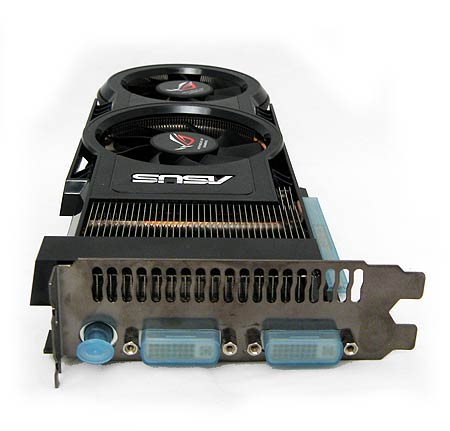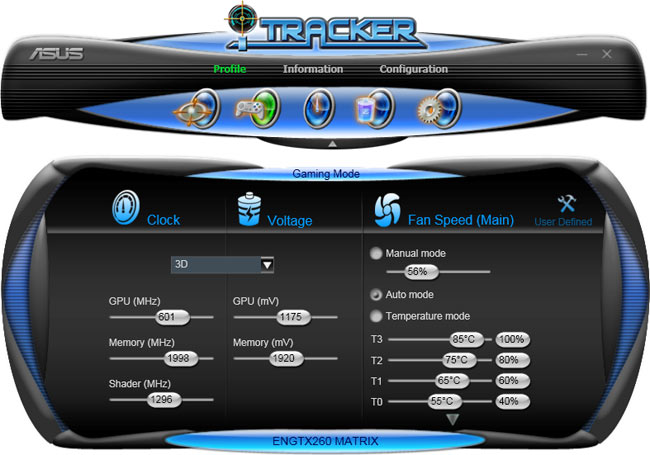GeForce 9600 GT/GTS 250/GTX 260 Non-Reference Roundup
Asus ENGTX260 Matrix, Cont’d
Like most of the GeForce cards in this roundup, the ENGTX260 Matrix has two DVI outputs and a single S-video output. With the included adapters, all the bases are covered, from HDMI to component video.
The clock speeds Asus chose to equip this powerful card with are a little strange. It's clocked similarly to a stock GeForce GTX 260, which is an odd choice for a premium offering capable of so much more. I assume Asus went this route to highlight the available control enabled through software. So, perhaps it wanted stock clocks to serve as the baseline: 576 MHz core clock, 1,242 MHz shader clock, and 999 MHZ (1,998 MHz DDR) memory clock.
Of course, the user is expected to install and utilize the bundled iTracker utility. This tool really gives you hooks into the guts of the Asus ENGTX260 Matrix. At its simplest level of control, the iTracker software can assign predefined clock profiles. We decided to apply the included gamer profile for our testing because it provides a realistic baseline of what even the most timid enthusiast can accomplish with this powerful card: 601 MHz GPU, 1,242 MHz on the shaders, and 999 MHZ (1,998 MHz DDR) on the memory.
Overclocking
Overclocking is what Asus' Matrix cards are designed to do, and our ENGTX260 sample didn’t disappoint. The iTracker utility allows for the creation of custom profiles that include not only clock speeds, but voltage and fan adjustments to make the process much more successful than a simple clock speed adjustment.
By adjusting these values with the iTracker utility, we managed to bring the card to an eye-opening 758 MHz GPU clock at 1.25 V, 1,504 MHz on the shaders, and 1,221 MHz (2,442 MHz DDR) at 2.0 V on the memory.This is an impressive result, and it provides the Asus Matrix card's bundled software utility with real credibility.
Get Tom's Hardware's best news and in-depth reviews, straight to your inbox.
Current page: Asus ENGTX260 Matrix, Cont’d
Prev Page Asus ENGTX260 Matrix Next Page MSI N260GTX Lightning Black EditionDon Woligroski was a former senior hardware editor for Tom's Hardware. He has covered a wide range of PC hardware topics, including CPUs, GPUs, system building, and emerging technologies.
-
Mottamort I was rather disappointed with this article. Not the article itself but with the slightly misleading Title/Intro. When clicking the article I thought I was going to find a massive battle between these vendors on different tiers, instead you show us different instances of 2 slightly different cards of the same type from one vendor....if that makes senseReply
I mean you have Gigabyte vs Gigabyte in the 9600gt section, Asus vs Asus in the 250 section and so on.
:-/ -
dragonsprayer Great articleReply
i wish it had more cards, i think you need 4 parts, try some back cards like the 4870x2 darkknight? good stuff as always!
thx! -
crisisavatar wow how is the gts 250 performing so close to the gtx 260 wasn't the gtx 260 20% faster ?Reply -
enterco It's not clear to me why are you comparing '3dmark score' when you should post 'GPU score'.... It's a graphics card comparision, not platform comparision.Reply -
randomizer entercoIt's not clear to me why are you comparing '3dmark score' when you should post 'GPU score'.... It's a graphics card comparision, not platform comparision.Nothing but the cards is changed so you're not comparing platforms.Reply -
acasel We cannot see clearly the bang for the buck card there if we ain't seeing some ati cards like the 4770 and others..Reply
The drop down menu sure is fast... :-) -
enterco randomizerNothing but the cards is changed so you're not comparing platforms.Sure. A reason more to show GPU score. 3dmark score is too much influenced by CPU's power, and it's no longer relevant, the way it used to be once...Reply
By using a Quad Core and a low-performing GPU you can achive same 3dmark score as using a dual core combined with a considerably stronger GPU, 3dmark Vantage gives too much credit to CPU. But the overall FPS in games it's often higher in the second case: dual core + better GPU. -
marraco Recent review showed the 260 being neck to neck with the 4870; both in price and performance, those cards are in the same point.Reply
Since my 8800GT should be between the 9600 and the 250, I guess that the best upgrade path is to buy a second 8800GT, reaching probably 260/4870 performance.
I searched the web for 8800GT SLI benckmark running in i7 920, but got no one single review...
I think that tomshardware should review non up-to-date cards as the 8800 and the ATI equivalents, in crossfilre/SLI, since for many users, it should make sense to buy a second card that to upgrade to a 260/4870.
older reviews on those cards does not accounted for the scalability on I7 x58 platform, and probably ATI and Nvidia dedicated more time tweaking drivers for newer cards, so maybe the 8800GT does not perform well today (the SLI on core 2/Quad did not worked very well in the past)

